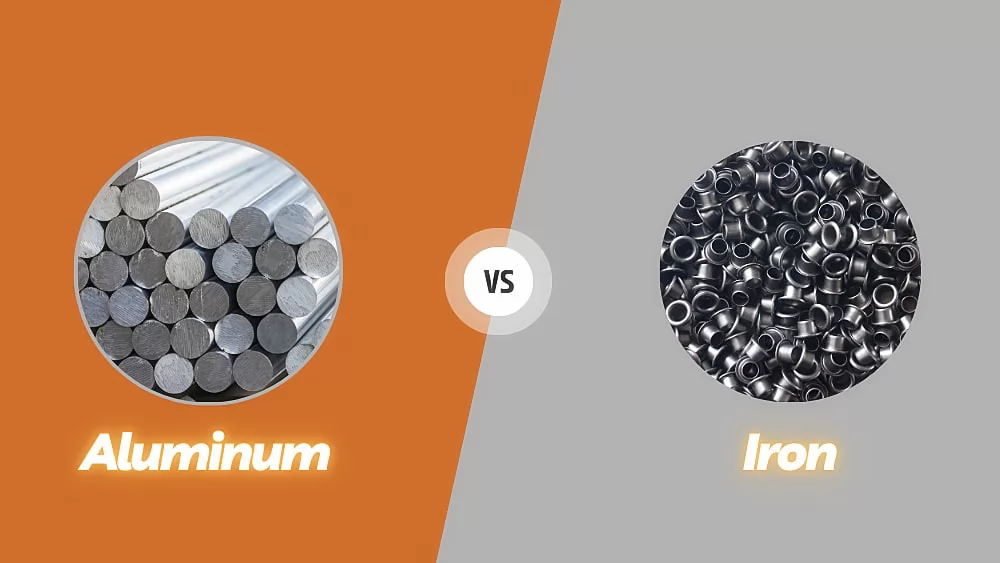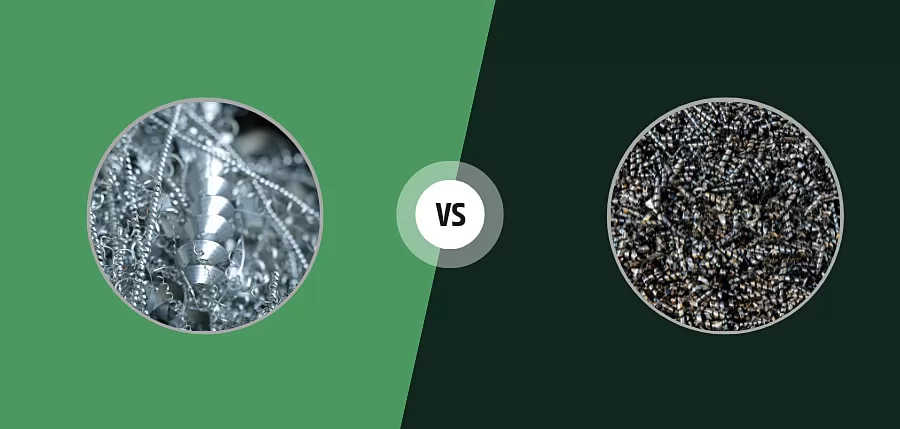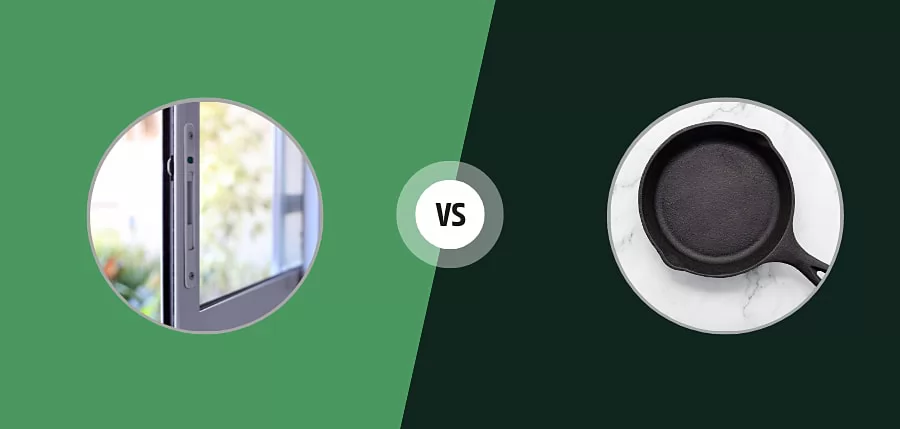
Are you wondering what the difference is between cast aluminum and cast iron? Comparisons between cast aluminum and cast iron are slowly becoming the norm, though there are several key differences when comparing cast aluminum vs. cast iron. These differences can affect which material is the best choice for a particular application. Read on to discover 8 differences between cast aluminum vs. cast iron and decide which is best for you. Let’s get started!
What is Cast Aluminum?
Cast aluminum is a lightweight, versatile metal that is formed by pouring molten aluminum into a mold to create a desired shape. This process is known as casting, and it’s widely used in the manufacturing industry due to aluminum's malleable nature, allowing it to be easily molded into complex forms. Cast aluminum is known for its excellent strength-to-weight ratio, making it an ideal choice for applications where weight is a critical factor, such as in the automotive, aerospace, and consumer goods industries.
Cast iron, on the other hand, is an iron-carbon alloy with a carbon content typically ranging between 2% and 4%. It is created by melting iron, adding carbon (and sometimes other alloys), and then pouring it into a mold to cool and solidify. The result is a dense, durable material that has been a staple in construction, machinery, and cookware for centuries.
Cast Aluminum Vs Cast Iron: Differences in Strength and Durability
When comparing cast aluminum and cast iron in terms of strength and durability, it’s important to understand that these materials are suited to different applications due to their inherent properties.
Strength:
-
Cast Aluminum: While aluminum is significantly lighter than iron, it does not have the same level of strength as cast iron. However, cast aluminum is still strong enough for many applications, especially when alloyed with other metals like magnesium or silicon. These alloys enhance the tensile strength and overall durability of cast aluminum, making it sufficient for use in automotive parts, machinery, and consumer goods that require a balance between weight and strength.
-
Cast Iron: Cast iron is renowned for its superior strength and ability to withstand heavy loads and high stress. It is particularly strong in compression, making it ideal for structural applications, engine components, and industrial machinery that require a material that can endure significant mechanical stress. The high carbon content in cast iron contributes to its rigidity and hardness, making it less prone to deformation under pressure.
Durability:
-
Cast Aluminum: Durability in cast aluminum comes from its corrosion resistance and overall toughness. The natural formation of an oxide layer on its surface helps prevent rust and corrosion, even in harsh environments. This makes cast aluminum durable in outdoor applications, where exposure to the elements is a concern. However, in terms of wear resistance, aluminum is softer than iron and may be more susceptible to scratches and dents over time.
-
Cast Iron: Durability is where cast iron truly shines. Its hardness and resistance to wear make it a long-lasting material for heavy-duty applications. Cast iron’s ability to retain its shape and resist damage under extreme conditions, such as high temperatures and heavy loads, contributes to its reputation for durability. However, its susceptibility to corrosion, particularly in moist environments, can be a disadvantage if not properly maintained.
Cast Aluminum Vs Cast Iron: Differences in Weight and Portability
Weight is a crucial factor when deciding between cast aluminum and cast iron, especially for applications where portability and ease of handling are important.
-
Cast Aluminum: One of the most significant advantages of cast aluminum is its lightweight nature. Aluminum has a density of around 2.7 g/cm³, which is roughly one-third that of cast iron. This makes cast aluminum parts much easier to handle, transport, and install, especially in large structures or devices where reducing weight is critical. The lightweight nature of aluminum is why it’s often used in the automotive and aerospace industries to improve fuel efficiency and performance.
-
Cast Iron: Cast iron, with a density of approximately 7.2 g/cm³, is considerably heavier than aluminum. This substantial weight adds to its stability and strength but makes it less desirable in applications where portability is important. For example, cast iron cookware, while excellent for cooking, is heavy and can be cumbersome to move or store. In industrial applications, the weight of cast iron components may require additional support structures or more robust handling equipment.
Cast Aluminum Vs Cast Iron: Differences in Thermal Conductivity
Thermal conductivity plays a crucial role in how materials respond to heat, making it an important consideration when choosing between cast aluminum and cast iron, particularly in applications like cookware, engine components, and heat exchangers.
-
Cast Aluminum: Aluminum is well-known for its excellent thermal conductivity. With a thermal conductivity of around 205 W/m·K, cast aluminum can rapidly absorb and evenly distribute heat. This property makes it ideal for applications where quick heat transfer is essential, such as in heat sinks, radiators, and high-performance cookware. For instance, aluminum cookware heats up quickly, which allows for precise temperature control during cooking. However, because aluminum cools down just as quickly, it may not retain heat as effectively as cast iron.
-
Cast Iron: Cast iron, while having a lower thermal conductivity than aluminum (approximately 52 W/m·K), is renowned for its superior heat retention. This means that once cast iron is heated, it holds onto that heat for a longer period, providing a more consistent and stable temperature. This quality is especially beneficial in cookware, where even heat distribution and long-lasting warmth are crucial for slow-cooking, baking, and frying. Cast iron’s ability to retain heat also makes it useful in applications like industrial furnaces and stoves, where maintaining high temperatures is important.
Cast Aluminum Vs Cast Iron: Differences in Corrosion Resistance
Corrosion resistance is a critical factor in determining the longevity and durability of materials, particularly in environments exposed to moisture, chemicals, and varying temperatures. Here’s how cast aluminum and cast iron compare:
-
Cast Aluminum: One of the standout features of cast aluminum is its natural resistance to corrosion. When exposed to air, aluminum forms a thin oxide layer on its surface, which acts as a protective barrier against further oxidation and corrosion. This makes cast aluminum highly suitable for outdoor applications, marine environments, and areas with high humidity. Products like outdoor furniture, marine components, and automotive parts benefit greatly from aluminum’s corrosion resistance, as they require minimal maintenance and have a longer lifespan in harsh conditions.
-
Cast Iron: Cast iron, on the other hand, is more susceptible to corrosion, especially in the presence of moisture. The high carbon content in cast iron can make it prone to rust if not properly protected or maintained. To prevent corrosion, cast iron often requires a protective coating, such as paint, enamel, or seasoning (in the case of cookware). Regular maintenance is essential to prevent rust and extend the life of cast iron products. In industrial applications, cast iron components may need additional treatments or coatings to withstand corrosive environments.
Cast Aluminum Vs Cast Iron: Differences in Machinability

Machinability refers to how easily a material can be cut, shaped, and finished during the manufacturing process. This aspect is particularly important for industries that require precise engineering and customization.
-
Cast Aluminum: Cast aluminum is known for its excellent machinability. It is relatively soft compared to other metals, which makes it easier to cut, drill, and machine. This quality allows manufacturers to create intricate and detailed components with high precision. The ease of machining also contributes to faster production times and lower manufacturing costs, making cast aluminum a preferred choice in industries such as automotive, aerospace, and consumer electronics. Additionally, the fine finish that can be achieved with aluminum makes it ideal for products where aesthetics are important.
-
Cast Iron: While cast iron is tougher and harder than aluminum, it is still machinable, though it requires more effort and specialized tools. The hardness of cast iron can cause wear on cutting tools, which may increase production costs and time. However, cast iron’s machinability is still good enough for creating heavy-duty components, such as engine blocks, industrial machinery parts, and large structural components. The ability to machine cast iron to tight tolerances makes it a reliable material for applications requiring high durability and precision.
Cast Aluminum Vs Cast Iron: Differences in Cost
Cost is a major consideration when selecting materials for manufacturing, construction, or consumer products. Understanding the cost differences between cast aluminum and cast iron can help businesses and consumers make informed decisions.
Material Cost:
-
Cast Aluminum: Aluminum is generally more expensive than iron, which contributes to a higher material cost for cast aluminum products. This cost difference is due to several factors, including the extraction process of aluminum from bauxite ore, which is more energy-intensive than iron extraction. However, the cost of aluminum can be offset by its lightweight properties, which reduce transportation and handling expenses. Additionally, the recyclability of aluminum helps recover some costs, as scrap aluminum is in high demand and can be reprocessed efficiently.
-
Cast Iron: Cast iron is typically more affordable than cast aluminum, making it an attractive option for applications where cost is a primary concern. Iron is abundant and relatively easy to process, which contributes to its lower price point. The lower material cost of cast iron is one reason why it is widely used in construction, heavy machinery, and large-scale industrial applications. Despite its lower cost, the durability and strength of cast iron make it a cost-effective choice for many long-term applications.
Manufacturing Costs:
-
Cast Aluminum: The manufacturing process for cast aluminum can be more costly due to the need for precise machining and finishing. However, the ease of machining aluminum can result in faster production times, which helps offset some of the higher material costs. Additionally, the lightweight nature of aluminum reduces transportation costs, which is a significant consideration in large-scale manufacturing or construction projects. For products that require complex shapes and fine details, aluminum’s ease of casting and finishing may justify the higher initial cost.
-
Cast Iron: While the material cost of cast iron is lower, the manufacturing process can be more labor-intensive, particularly when dealing with the material’s hardness. Machining cast iron requires more durable tools and slower cutting speeds, which can increase production costs. However, for heavy-duty applications where the durability of cast iron is crucial, the manufacturing costs are often justified by the material’s long lifespan and performance. In some cases, the cost savings from using a less expensive material like cast iron outweigh the additional manufacturing expenses.
Cast Aluminum Vs Cast Iron: Differences in Environmental Impact
In today’s world, where sustainability and environmental responsibility are increasingly prioritized, the environmental impact of materials plays a crucial role in decision-making. Here’s how cast aluminum and cast iron compare in terms of their ecological footprint.
-
Cast Aluminum: Producing aluminum from raw materials (bauxite ore) is energy-intensive, requiring a significant amount of electricity, often from non-renewable sources. However, once produced, aluminum is highly recyclable, and recycling aluminum consumes only about 5% of the energy needed to produce new aluminum. This recyclability means that aluminum products can be reprocessed multiple times with minimal energy input, making aluminum a more sustainable choice in the long term. The lower weight of aluminum also contributes to reduced energy consumption in transportation, further lessening its environmental impact.
-
Cast Iron: The production of cast iron is less energy-intensive compared to aluminum, as iron is more readily available and requires less processing. However, the recycling process for cast iron is more complex and energy-consuming, though it remains feasible. The environmental impact of cast iron is also influenced by its durability; because cast iron products tend to last longer, they may need to be replaced less frequently, which can offset some of the environmental costs associated with their production.
Cast Aluminum Vs Cast Iron: Differences in Applications

The unique properties of cast aluminum and cast iron make them suitable for a wide range of applications, each with its advantages depending on the specific requirements of the task.
Common Applications of Cast Aluminum:
- Automotive and aerospace parts: Cast aluminum is used to manufacture engine blocks, cylinder heads, and rims for automobiles, as well as fuselages and engine parts for aerospace. Its lightweight and high-strength properties help improve performance and efficiency.
- Cookware: Cast aluminum is widely used in pots and baking utensils such as frying pans, stew pots, baking pans, and cake molds. Its excellent thermal conductivity allows for even and rapid heating.
- Architecture and building decoration: In the construction field, cast aluminum is used to manufacture window frames, door frames, exterior wall finishes, and decorative elements such as flower beds and lamp posts. It is particularly suitable for outdoor use due to its corrosion resistance.
- Electronic equipment and radiators: Cast aluminum is used in the housings, radiators, and cooling systems of electronic equipment to help effectively manage the heat of electronic components and ensure stable operation of the equipment.
Common Applications of Cast Iron:
- Cookware: Cast iron is renowned for its excellent heat retention and even cooking. Skillets, Dutch ovens, and griddles made from cast iron are staples in many kitchens, valued for their ability to maintain consistent cooking temperatures.
- Pipes and Fittings: Cast iron is widely used in plumbing and drainage systems due to its durability and strength. Cast iron pipes and fittings are commonly found in older buildings and are still used in specific applications requiring robust materials.
- Engine Blocks and Machinery: The strength and durability of cast iron make it a preferred material for heavy-duty applications, such as engine blocks, industrial machinery, and agricultural equipment. Cast iron can withstand high stress and heavy loads, making it ideal for these applications.
- Architectural Features: Cast iron has a long history of use in architectural elements, including columns, railings, and structural components. Its ability to be cast into ornate shapes also makes it popular for decorative features in historical and industrial-style buildings.
How Do You Choose Between Cast Aluminum and Cast Iron?
- Weight: Cast aluminum is lighter, ideal for projects needing reduced weight. Cast iron is heavier and better for stability.
- Strength & Durability: Cast iron is stronger and more durable, suitable for heavy-duty applications. Cast aluminum is less strong but has a good strength-to-weight ratio.
- Corrosion Resistance: Cast aluminum resists corrosion well, making it good for outdoor use. Cast iron can rust without proper coating.
- Thermal Conductivity: Cast aluminum dissipates heat quickly, while cast iron retains heat longer, making it great for cookware.
- Cost: Cast iron is generally cheaper, but cast aluminum’s properties can justify its higher cost in specific applications.
Choose cast aluminum for lightweight, corrosion-resistant projects and cast iron for strength, durability, and cost-effectiveness.
Conclusion
Choosing between cast aluminum and cast iron ultimately depends on the specific needs of your project or application. Both materials have distinct advantages and disadvantages and are suitable for different uses.
If you have any further questions about cast aluminum or cast iron, or if you need further assistance in choosing the right material for your application, please feel free to contact us. We are here to help you make the best choice for your project!



